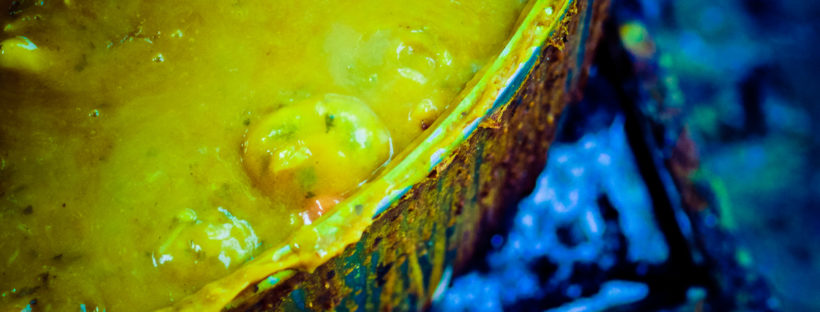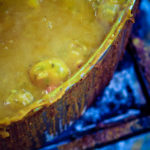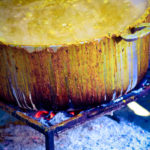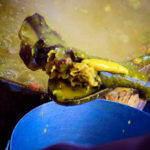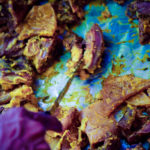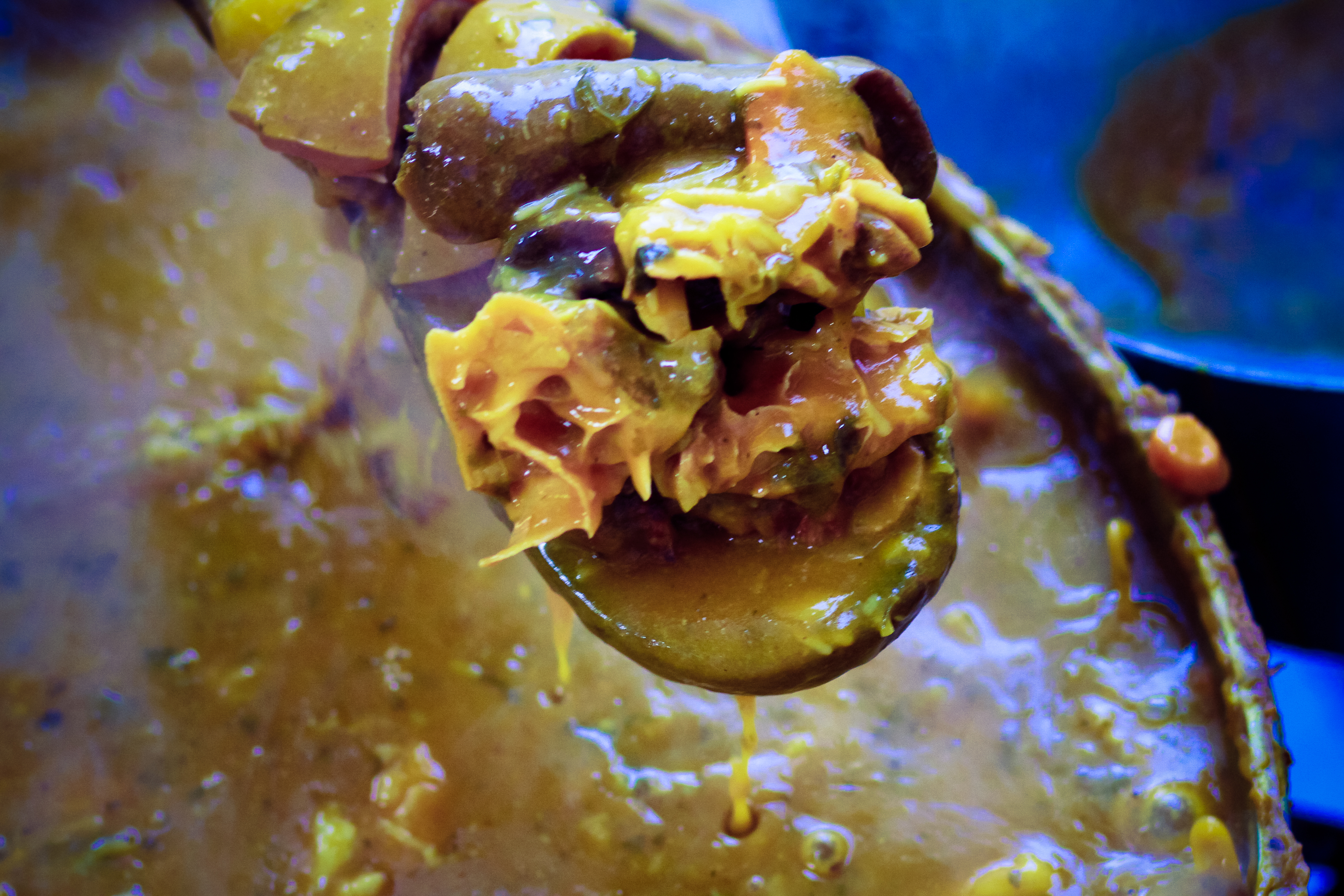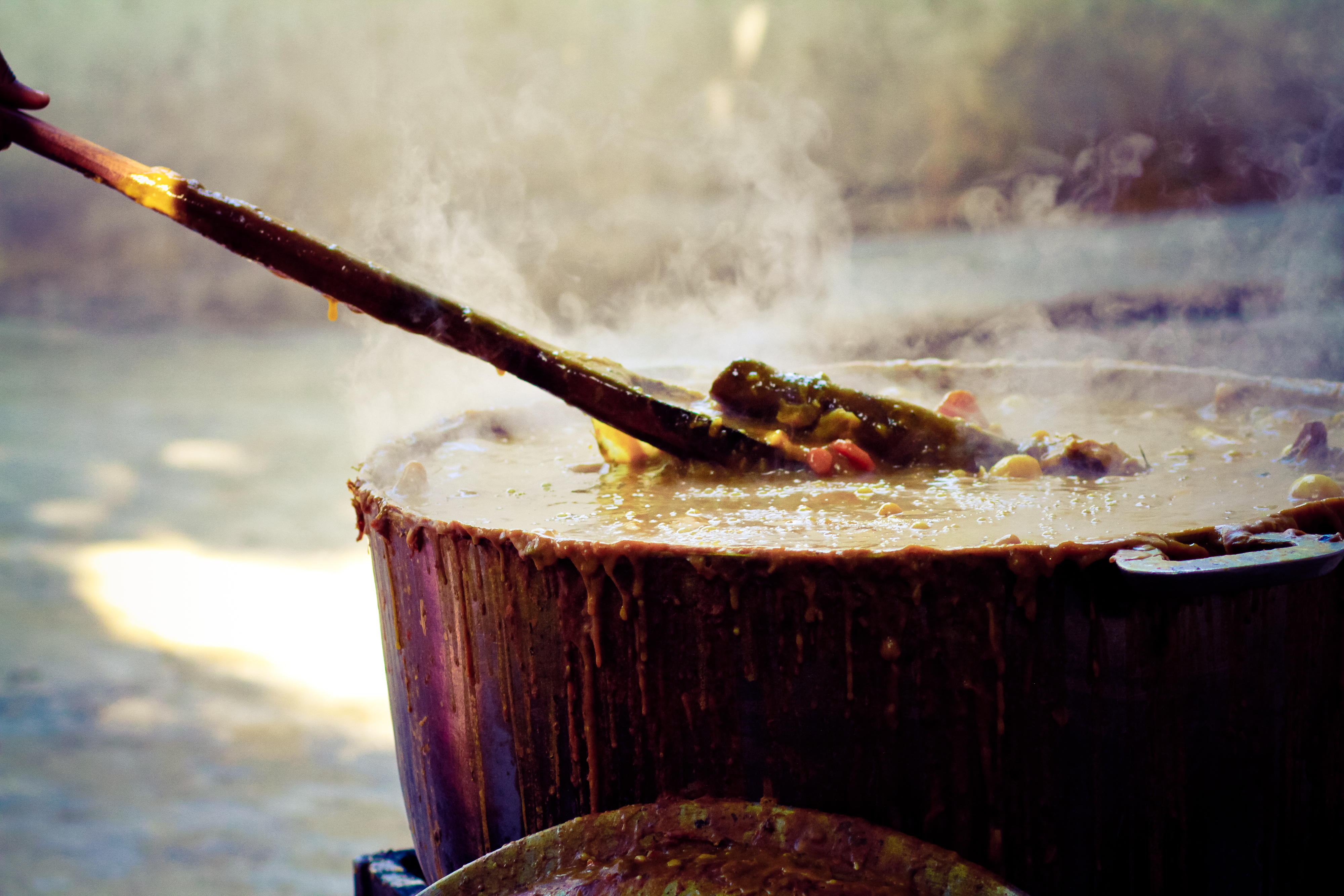The girls began pummeling garlic and parsley in three separate batches, in wooden mortar and pestles on New Year’s Eve.
Twenty girls strong were all participating in a task associated with the famous Haitian Winter Squash Soup known as Soup Joumou or Freedom Soup.
To make enough soup for 40 people the girls would cut, chop, pound, puree and stir into the wee hours of the night. Then a shift of girls would go to sleep and a new round of girls from the OJFA girls empowerment center would arise and take up the baton, in this case a long wooden spoon.
Sometime around noon on New Year’s Day everyone sat down to a giant bowl of soup.
As we ate, I wondered where this delicious soup came from and why everyone was eating it. Up and down alleys, streets and boulevards you could see Haitians hunched over eating soup. Delicious soup.
“The soup was considered superior,” Marie Romelus says. “The slave – they were considered as lower class. So when we get our independence, we were free to have a soup.” – NPR Article, Belly Full of Soup
After more digging, someone at Atis Rezistans mentioned Claire Heureuse.
After careful digging, I read her inspirational story.
New Year’s Day marks each anniversary of Haiti’s independence from the French and the birth of the world’s first black independent nation. To celebrate independence, Marie-Claire Heureuse Felicite, the wife of revolutionary leader Jean-Jacque Dessalines, proclaimed that on this day no Haitian should go without a bowl of pumpkin soup (Soup Joumou). A colorful and delicious item on every Haitian New Year menu.
…
Marie-Claire Heureuse Félicité (1758 – 8 August 1858) was the Empress of Haiti as the spouse of Jean-Jacques Dessalines. During the siege of Jacmel in 1800, she made herself a name for her work for the wounded and starving. She managed to convince Dessalines, who was one of the parties besieging the city, to allow some roads to the city to be opened, so that the wounded in the city could receive help. She led a procession of women and children with food, clothes and medicine back to the city, and then arranged for the food to be cooked on the streets.On 21 October 1801, she married Jean-Jacques Dessalines. She was described as kind, merciful and natural, with an elegant and cordial manner. She legitimized the children produced by Dessalines’ adulterous affairs. She was a contrast to her husband in her tolerance and support and by showing indiscriminate kindness to people of all colors. She was a great opponent of Dessalines’ policy toward the white French people of Haiti; she saw to the needs of the prisoners, and she did not hesitate, despite her husband’s anger, to save many of them from the 1804 Haiti Massacre arranged by her husband. She is reported to have fallen to her knees before him to beg him to spare their lives and is said to have hidden one of them, Descourtilz, under her own bed to save him. She was made Empress of Haiti in 1804 upon the creation of the monarchy of Haiti, and crowned with her husband at the Church of Champ-de-Mars on 8 October 1804. She kept the status for two years.
After the deposition and death of her Dessalines in 1806, she denied the offer from Henry Christophe to move in with his family. As a widow, she was styled Princess Dowager on 17 October 1806. As the property of her late husband was confiscated, she lived in poverty in Saint-Marc until August 1843, when she was granted a pension 1,200 gourdes.
…
So it was Claire Heureuse who took to leading women into the streets to cook food out in the open, to be shared with all.
Soup Joumou is a mildly spicy soup native to Haitian cuisine, although variations of it can be found throughout Latin America and the Caribbean.
This savory pumpkin soup is served in Haiti on January 1, the anniversary of Haiti’s liberation from France. It is said that the soup was once a delicacy reserved for white masters but forbidden to the slaves who cooked it. After Independence, Haitians took to eating it to celebrate the world’s first and only successful slave revolution resulting in an independent nation.
The soup is based on winter squash. The squash slices are simmered in a saucepan along with pieces of beef, potato, plaintains and vegetables such as parsley, carrots,green cabbage,celery and onions. The squash is puréed, usually in a food processor, with water and the purée is returned to the saucepan, where salt and seasoning along with garlic and other herbs and spices are added. Thin pasta such as vermicelli and macaroni and a small amount of butter or oil is sometimes also put in. The soup is always served hot and is usually accompanied with a sliced bread with which to dip in the soup.
Soup Joumou Recipe
Beef marinate made by crushing 4 garlic cloves, 1 teaspoon thyme 1/4 teaspoon pepper, shallot and 2 sliced scallions and 2 teaspoons of salt
1-pound piece of beef stew meat
10 cups water (add more later if necessary to make soup less thick)
1 whole scotch bonnet pepper with stem
2 pounds pumpkin (or winter squash / butternut), peeled and chopped
2 carrots peeled and sliced
2 stalks celery sliced lengthwise and cut into pieces
5 parsley sprigs
1 large onion cubed
2 medium turnips peeled and cubed
2 medium potatoes peeled and cubed
1 pound cabbage sliced fine and chopped
1/4 pound vermicelli or other thin pasta, broken into shorter lengths
2 limes juiced
1/4 can tomato paste (for browning meat)
1/2 cup or 1 can tomato sauce
1 low sodium beef bouillon cube (if you’d like more flavor)
Directions
1.In a medium pot, cook pumpkin over medium heat in 6 cups water for 30 minutes. Purée pumpkin in the water.
While the pumpkin is cooking, clean meat with lime, rinse with hot water and drain. Marinate meat with meat rub. Rub the meat with the spice paste-scallions, onion, thyme, garlic, shallot, , green pepper, salt and black pepper ground together. (For an enhanced flavor, you can marinate the meat from 1 hour up to one day in advance.)
2. In stockpot, add the meat with the oil and tomato paste and brown by adding small amounts of water to caremelize the meat. Cook covered over medium heat for 20 minutes. Add 3 cups water and puréed pumpkin and bring to a boil.
3. Add the cabbage, carrots, celery, onion, turnips, tomato sauce, potato and parsley to the soup, bring to a boil, then reduce heat and simmer for 1 hour with a whole scotch bonnet on top. (The whole scotch bonnet is for flavoring not to make the soup “hot”. Remember to find and remove the pepper as you stir the soup and remove it before it bursts)
6. Add the spaghetti broken in to short pieces and cook until soft and tender.
7. Taste and add a minimal ammount of salt, black pepper or hot pepper to taste.
8. Turn off the heat, cover the pot, and let sit until ready to serve.
Makes 10 one-cup servings.
Number of Servings: 10
